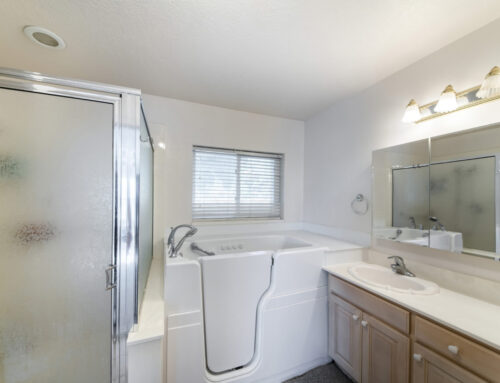The aging-in-place movement has added a whole new level of independent living options for seniors that don’t exist in the nursing home model of senior care.

To be sure, many seniors prefer to stay at home during their golden years. Indeed, their health and well-being can thrive when they are allowed to live out their final years in the place they know best.
However, aging-at-home does come with a price, according an article on CNBC. Getting help at home as opposed to going to a managed care facility runs about $4K a month compared to the price of assisted living, which is $37K and some change. That said, nursing homes will usually cost over $8,000 per month for a private room.
Fortunately, as AARP points out, people who plan for their senior years during their 40’s and 50’s avoid the “emergency plan” for retirement, which typically involves having a loved one take care of you. This loved one is often unpaid, and 40.4 million of them are not only unpaid but seniors themselves. That is to say, they are people who are 65 years or older who are caring for parents who are even older still.

1. Make an Assessment
Part of the issue lies in human longevity, ironically. According to NPR, in 1950, the average age of death was 68. Nowadays, it’s 79 and climbing. And six million Americans have reached the age of 85 or older.
For many people in this predicament, planning for elderly parents and planning for themselves at the same time has become commonplace. Further adding to the issue is the fact that because people are living longer. This means that if they retire at 65 and live for another 30 or 40 years, they may not have the money they need to fund their retirement years.
Clearly, they key is to plan ahead. This ensures that those who are in need of care have the wherewithal to care for themselves, and this should happen long before they start looking for a caregiver.
This isn’t to say that family members can’t pitch in and help. Many adult children of aging parents say that caring for their parents creates meaning in their lives. Any planning for care can and should include the tasks that adult children can and want to do for their parents.
If these adult children have already begun to help their parents so that they can remain in their home for at least some of their senior years, it’s important to assess what these family members are doing. (Or if they’re not yet helping, it’s important to anticipate the kinds of tasks they may need done.)
Here’s a list of some, though they don’t represent all of the tasks that an elderly set of parents may require:
- cleaning help around the house
- good shopping, meal prep, and cooking duties
- hygiene care
- errands
- financial planning
People who are ahead of the game plan for these tasks before they reach their golden years. They have set aside money for their lives and for their care.

2. Managing Cash Flow
People who are planning for elderly parents (or for themselves) must take into consideration how much it costs to live in a long-term care facility, like nursing homes versus the costs of aging-in-place. Somewhere in the middle of these two options on the spectrum sits the option for independent living in a senior apartment complex.
Those who want to plan for their own care (as opposed to needing emergency care from a relative) should start their retirement budget early, according to The Balance.
Their financial/ retirement assessment should include, but is not limited to:
- their retirement date
- the return on their investments
- taxes
- social security, pensions, and other forms of income
- a possible budget for all retirement options, including care-at-home, in a senior living complex, and in a nursing facility
- health care costs and insurance
- transportation costs (How will you/ your parents get to doctor’s appointments, for example?)
- daily care needs (Activities of Daily Living, or ADLs)
Completing this task may require the help of a financial planner.

3. Assign Personal Care Duties
If after making their financial assessment, a family has decided that their parents will age-in-place, at least for the time being, they’ll want to start looking for a personal care assistant of some kind.
Knowing what kind of care to get will depend on what a person’s initial assessment has turned up and what they have budgeted for. However, there are some initial questions that a person can ask to help themselves determine the level of care they or their parents may need.
Ask the following:
- What does the person need help with or is already getting help with?
- Do they require daytime help?
- Do they need nighttime help, too?
- Are they at a place where they need constant supervision?
- Can this care be realistically and reasonably expected from family and friends?
- Would adult daycare help? Or a volunteer associated with the local senior center?
- Can some of their care needs be automated through Amazon, CVS, or Walgreens?
Finally, please not that experienced caregivers can be expensive, but worth it.

4. Meal Plan Options
The health and well-being of the seniors in our midst starts with nutrition and wellness. Shopping for food and meal preparations, as well as cooking count as common tasks that a caregiver provides.
As with anything on this list, plenty of options are available for seniors in need of meals. Naturally, those seniors who love to cook and who are still mobile enough to shop for themselves should do so. For those who aren’t able to shop, but still want to cook for themselves, The Senior List suggests that these seniors go for a meal delivery service, like Silver Cuisine.
These meals come in kits. They do still require some cutting and cooking, but they remove the shopping component from the equation, which helps seniors who have lost some of their mobility.
Other meal options include:
- help from volunteers
- Meals on Wheels
- family and friends who take turns cooking for and delivering food
- meal-prep done by an in-home caregiver
- other options
A living assessment should be done for seniors who want to do their own cooking. This option may require some home modifications to make it realistic.

5. Make Home Modifications
One of the reasons why people opt for senior apartments or for a long-term care facility is that these spaces have already been modified for seniors. However, home modifications for seniors who opt to stay home instead are often required to make aging-at-home a realistic option.
These modifications often include:
- modifications made to doorways to make them wider to accommodate wheelchairs or walkers
- kitchen modifications, which lower cabinets and the sink, the addition of a microwave stand, and other changes
- ramps going into the house
- bathroom modifications, like adding bars and non-stick surfaces to tubs and showers
- etc.
A contractor that specializes in home modifications for seniors can make recommendations. Again, as with all of the expenses on this list, these changes should be planned for, ideally many years in advance.

6. Other Independent Living Options
For those who face taking care of a parent who didn’t plan for their retirement, some options are still available. Many cities have senior centers, which not only have things for seniors to do, but community resource information.
These facilities will know about community resources, like:
- local, state, and federal government and community resources
- agencies on aging in the area
- social services
- the VA
- religious or tribal groups that provide care
- other options
Final Thoughts on Aging in Place
Many people in their twilight years opt to stay home instead of going to an assisted living facility, senior apartments, or a nursing home. While these facilities offer a number of benefits, including providing things for seniors to do and around-the-clock care in some cases, many seniors have started to look for help at home to replace many of the services these places provide.
However, looking for a caregiver can be a lengthy process. The ideal person is patient, compassionate, dependable, and trustworthy. The best time to look for a caregiver is when a caregiver isn’t needed, meaning that it’s not an emergency. This allows the family to take their time with each potential client.
All of this said, aging-in-place plans may need to be replaced by other care options, including assisted living or a nursing home facility. Ideally, the person going into care should have planned for this eventuality long before he/ she needed it.



